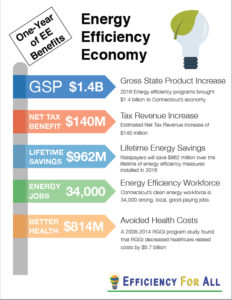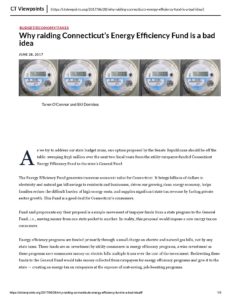Dear DEEP, PURA, Office of Consumer Council (OCC) and State Leaders,
Efficiency For All (EFA) has been working diligently to educate our state’s leaders and our communities about the diversion of funding which has already reduced access to energy efficiency programs and is resulting in job losses in our state. This two year diversion of ratepayer funding to the States’ general fund diverted three separate funding sources. These three funding sources supported different parts of the State’s clean energy plan.
1. Regional Greenhouse Gas Initiative (RGGI) – A multi-state, market-based, mandatory emission allowance auction program for fossil-fuel power plants. Proceeds in Connecticut are distributed as such: 70% to the C&LM budget, 23% to the CT Green Bank, and 7% to CT DEEP. Within the C&LM budget, RGGI proceeds are primarily used to service oil/propane heated buildings. This diversion of RGGI funds has resulted in almost no access to direct install energy saving services for 75% to 80% of oil and propane heated homes. These oil and propane households will not be able to receive the HES service even though they still pay into the C&LM funds on their electric bills. The 2017 budget diverted $10,000,000 per year for FY18 and FY19 (74% of 2017 auction proceeds).
2. Conservation and Load Management Plan (C&LM) – The statutory framework for CT’s energy efficiency programs, funded primarily by a charge on ratepayer electric and natural gas bills into the Connecticut Energy Efficiency Fund (CEEF). The C&LM Plan provides the guidelines to administer direct residential and commercial energy efficiency services along with outreach and education in an effort to meet CT’s demand reduction and efficiency goals. The 2017 budget diverted $63,500,000 per year for FY18 and FY19 (33% of 2017 budget).
3. The CT Green Bank uses public ratepayer funds to attract private investment for clean energy projects throughout the state. The CT Green Bank is funded in part by the Connecticut Clean Energy Fund (CCEF), which is a one-mil charge on ratepayer utility bills. The 2017 budget diverted $14,000,000 per year for FY18 and FY19 (53% of FY17 CCEF proceeds).
Unfortunately many leaders and communities are still confused about which funds do what, where the funds are generated, and what programs the funds actually support. Please note that you can locate reports and current information at www.efficiencyforall.org.
Our shared goal is to ensure that all the funds are returned to serve ratepayers and to meet our state’s Comprehensive Energy Strategy (CES) goals. It is critical when allocating funding that there be a clear focus on the importance of service to ratepayers, the reduction of energy waste, jobs in Connecticut, benefits to the local economy, and the reduction of peak demand, which lowers the cost of energy in Connecticut for all.
Energy Efficiency (EE) is still the most effective way to reduce energy waste, and offers the highest ROI for ratepayers. EE provides the most local jobs, and is the biggest support to local our economy.
Because energy efficiency is the best way to meet our state’s goals, we are advocating for the following actions at the state level. CT DEEP’s Comprehensive Energy Strategy (CES) released in February pointed to Energy Efficiency as the most prominent part of the state’s CES. However, we can not meet those goals if EE is not supported with ratepayer funding (which has been diverted), or if EE is not planned for and not implemented.
We are looking for your active support of the following actions in 2018
1. Protect energy efficiency fund ratepayer dollars from budget diversions in Connecticut through the implementation of specific statues which do not allow for diversions of ratepayer money to the general fund.
An Act Repealing Diversions of Ratepayer Energy Efficiency and Clean Energy Funds
To undo state budget diversion of electric ratepayer funds from cost-effective energy efficiency and clean energy programs and support equal access (fuel blind) to state energy efficiency funds which: reduce the state’s dependence on nonrenewable energy resources, reduce the cost of energy generation, and mitigate the impacts of air and water pollution protecting human health.
2. Implement legislation for a “Fuel Blind (Fuel Neutral) program of direct energy efficiency services for all ratepayers in Connecticut”. We are requesting legislation to ensure that all ratepayers have equal access to ratepayer funded programs regardless of socio-economic status or fuel type. All electric ratepayers are paying into the C&LM funds; Therefore all ratepayers should have the opportunity to access the direct service programs which support health, safety, and energy savings.
3. FIX RATEPAYER IMPACT STATEMENT– Studies which only count cost and do not quantify non-cost benefits are biased. Connecticut must Implement Non Energy Impact (NEI) testing for EE programs in Connecticut. This simple step to properly track and quantify EE benefits such as, but not limited to: the state GSP, lowered cost of energy infrastructure, reduced healthcare costs, improved health, the protection of at risk communities, and net tax revenues will correct the way in which we quantify the data and properly track EE outcomes and results.
Clarifications on the IMPORTANCE of direct service to the ratepayer and direct EE measures
Energy Efficiency is not a subsidy and does not cost the state of Connecticut any money: CT Energy Efficiency programs are not a subsidy. They are paid for by the ratepayers and directly serve the ratepayers, resulting in proven, on the spot, long-term energy savings to the ratepayers and the energy grid. This results in reduced peak demand, lowered pollution, lowered carbon emissions, as well as lowered energy costs to CT businesses, schools, and state properties alike. Efficiency for All is attempting to openly clarify that EE contractors employ staff and subcontractors for the specific purposes of direct service to ratepayers. These direct service contractors do not receive any subsidies and are only compensated for direct installation of pre-approved, high ROI, energy saving measures.
Energy Efficiency helps at-risk populations and working families, businesses, schools, churches, and the State of Connecticut. EE has the unique ability to free up financial resources, allowing the funds to be used for whatever is needed most such as, food, medicine, education, housing, business growth, or the state’s budget. Energy efficiency even helps renewable energy go further, and helps us all to avoid the rising burden of the costs of energy.
The Connecticut Energy Efficiency industry includes 34,000 jobs . Solar only accounts for 6,000 – 8,000 jobs in CT. The EE jobs are high paying jobs for local Connecticut residents. The EE programs utilize C&LM collected ratepayer funds to directly serve ratepayers. EE workers can earn between $16 and $30 an hour. These jobs offer benefits and hire CT residents. Our workers pay taxes, vote, own property, and shop in CT.
Restoring only the Green Bank funds and increasing the amount of ratepayer funds to the Green Bank allocation will not save 34k jobs or help oil and propane customers who can no longer receive direct services which they have paid for and are still contributing to at this time. The clean energy programs do not lower peak demand or lower energy costs directly in the way that energy efficiency, can and does, lower these impacts on ratepayers and businesses in Connecticut. The Green Bank is an important asset, but the ratepayer, the economy, and our jobs should come first.
Q: How can our leaders help create a stable energy and economic future?
A: EFA and our stakeholders formally request that DEEP, PURA, and our state’s legislators take immediate action to request the ratepayer funds not be diverted.
We further request that DEEP and PURA ensure that any restored funds are utilized for “Direct Services to Ratepayers” and are not utilized for overhead, administrative fees, upstream rebates, or unnecessary “innovation” in funding unproven ideas. EE has a well documented track record and nationally supported positive outcomes to meet our states goals.
We further request the creation of a “fuel blind (fuel neutral) program which is equally accessible to all electric ratepayers” and request that our leaders do not simply divert the ratepayer funding to the Green Bank, or a new Green Bank nonprofit entity.
EFA asserts that Governor’s Bill 9 and Bill 10, submitted by the Governor for legislative action, Do NOT address the diversion of C&LM funding in the amount of $63,500,000 dollars per year. These funds were collected via utility bills under the “COMBINED PUBLIC BENEFITS CHARGE”. The programs provide direct energy efficiency services and upgrades in homes, businesses, and buildings across Connecticut. The diversion of funding away from the C&LM and these programs is not addressed in Bill’s 9 or 10.
Governor’s Bills 9 and 10 will NOT protect the direct energy efficiency services to ratepayers, or the 34,000 jobs which these programs support directly and indirectly. The EE workforce is experiencing the first wave of layoffs are turning away oil and propane customers from accessing services which would lower their energy bills, and our state’s peak energy demand. More layoffs will begin soon if funds are not restored.
Energy efficiency has the advantage of reducing all types of power plant-related emissions simultaneously by avoiding the need to generate electricity in the first place. Whenever households and businesses reduce electricity consumption, they reduce the need to generate additional electric energy. The avoided generation from expensive fossil fuel-fired power plants is desirable to reduce energy costs, and air pollutant emissions. This results in improved human health, while slowing climate change.
The return on investment (ROI) of EE direct services is higher than all other forms of clean energy (2018 CES). EE supports local jobs, as well as providing additional quantified and well documented economic benefits, and improved health outcomes in at risk communities.
Fact sheets are available on this website and EFA is available to meet with leaders, legislators, community groups, or stakeholders to provide detailed data on the direct impacts to EE jobs, programs, and ratepayers.
Please join support us and protect the ratepayer funds, equity based energy efficiency, local jobs, and our environment through the direct energy efficiency services to Connecticut ratepayers.
We look forward to your response and the opportunity to answer questions.
Respectfully,
Efficiency For All member, stakeholders, and contractors
Leticia Colon de Mejias, EFA co-chair , Tel: 860-580-9076, Lcolonees@gmail.com
Kyle Ellsworth, Director of Community Relations & Government Affairs, EFA Tel: 860-337-2239, Kyle.ellsworth@efficiencyforall.org
|
Why raiding Connecticut’s Energy Efficiency Fund is a bad idea |



